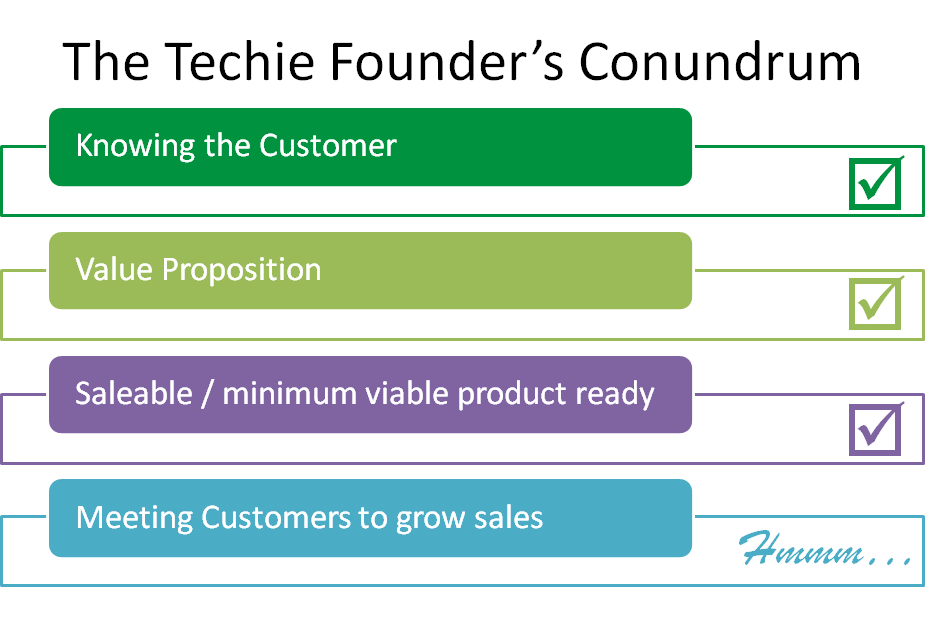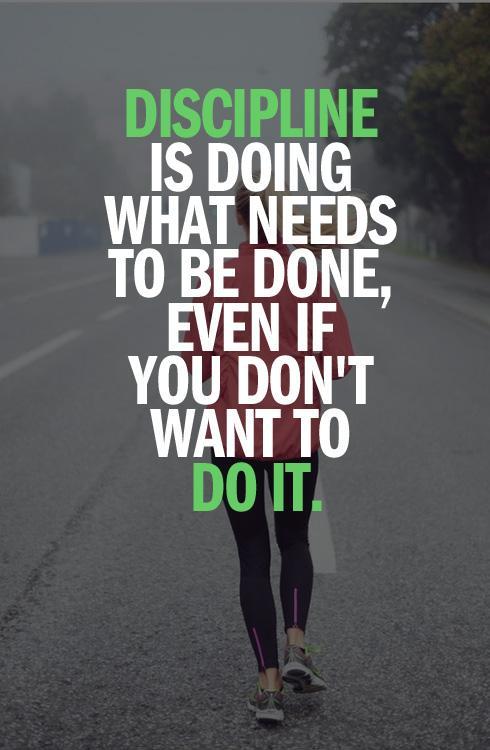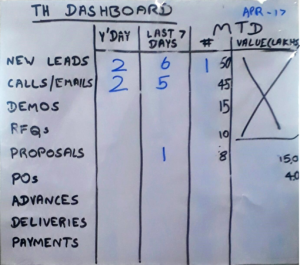 Prologue: The Conundrum
Prologue: The Conundrum
Once upon a time, I was a techie. A typical boy who embraced his family’s respect for the technical professions, got admitted to a solid engineering college, came out with a respected, traditional engineering degree, and built his chops as a corporate professional for 9 years. Then, I got into business. And took some years of my prime, to learn some new lessons and unlearn some old ones.
I got into building very niche software for manufacturing companies. I believe I’ve always had a nose for distinctive value, so from the outset, our products had the ability to attract potential clients. But then there I was, a startup founder who had not quite grown out of his techie roots, tied down still with all the accompanying mental blocks. Chief of which I shall call The Techie Founder’s Conundrum.

The Techie Founder’s Conundrum: Everything is in place. Now if only someone could come by and sell this thing for me…
If you’ve also hung around the startup community, you may also recognize that unfortunately, this is a far-from-uncommon problem among startup founders.
I used to think to myself: I can’t sell! I need a co-founder who can sell for me.
The good news: You can overcome this problem.
The seemingly-bad-until-you-realize-it’s-actually-good news: You’ll have to overcome it yourself. And unless you happen to have a co-founder who has as much skin in the game as you, you cannot depend on anybody.
Book One: The Epiphany

What R.R. Martin didn’t tell you – Arya Stark’s real epiphany
Due apologies to those unfamiliar with Game of Thrones (along with a strong recommendation to binge-watch all 6 seasons now). The transition from a techie to a sales person, is much like Arya Stark’s journey of self-discovery. It’s first and foremost a mental switch that you must find inside yourself.
For me, the switch was triggered during a discussion with a mentor of mine, where he emphasized that nobody else in the world would understand my product as well as I did, and therefore, initially & maybe forever, nobody else in the world could sell it as well as I could. Accept this fact, however grudgingly, and get out in front of your first few customers. Nothing breeds confidence like practice.
Once you go through your first few client meetings (particularly unknown clients), you’ll come to realize that the Epiphany is really overrated.
Book Two: The Prescription
I’m not a great sales person. Definitely not one among the Brian Tracy’s, Shiv Khera’s or Jordan Belfort’s of the world. I’m not one of those guys who can walk into a sales interview and sell the proverbial Reynolds pen to the know-it-all interviewer for ₹ 500. I don’t think I’ll ever count myself as a great over-the-table negotiator. I suck at most of those classical techniques you’ve heard sales people brag of.
However, today I’m a confident sales person, and have executed a few sales and built enduring customer relationships. So what’s the silver bullet?
“You think you need to figure out how to become a great salesperson? There is no silver bullet that’s going to fix that. No, you are going to have to use a lot of lead bullets.”
(slightly adapted from Horowitz, Ben. The Hard Thing About Hard Things: Building a Business When There Are No Easy Answers (p. 88). HarperCollins. Kindle Edition.)
Sales, in my opinion, is mostly nothing of all those flashy Hollywood techniques unfortunately associated with the profession. Instead, particularly for a small startup, I believe sales success can be distilled into 3 simple lead bullets.
1. Build the Numbers
 You’ve heard variants of this statement often enough – “Sales is a profession built around handling rejection”
You’ve heard variants of this statement often enough – “Sales is a profession built around handling rejection”
A fabulous guru-type sound bite to deliver at a startup event, inevitably followed by the somber, agreeing nods of your audience.
However, try telling yourself this statement when you’ve just been rejected by a Customer. When you think of all the hours spent on understanding the client, building the proposal, explaining it to them, handling and cowing down to their negotiations; when your mouth goes dry on the realization that all the effort was for naught, try selling yourself this sound bite.
Nevertheless, it’s true, isn’t it? The sooner you can handle that rejection and move on, the better for your team. Forget the psychology lessons, forget the empathetic friends’ hand on your shoulder, forget your spouse comforting you. If there’s one balm that will relieve the pain of that rejection better than any other – it’s the scheduled meeting with the next potential client.
So, build the numbers in your Sales Funnel. Figure out how to get more leads or referrals (a topic in itself for another day), how to qualify them quickly, how get get the demo meetings or whatever leads to the client understanding your product or service.
When the Customer kicks you off their tower onto the street below, there’s nothing like the cushion of a healthy sales funnel to soften the impact.
2. Set the Disciplines
 Sales excellence comes from doing the same simple things, day after day after day after day, better and better and better. But what would these simple things be? My humble suggestions:
Sales excellence comes from doing the same simple things, day after day after day after day, better and better and better. But what would these simple things be? My humble suggestions:
- Get yourself a tool for sales funnel activity tracking. Not necessarily one of the expensive & sophisticated CRM solutions (though nothing stops you from purchasing those if you will use them well). It can be as simple as an Excel worksheet. It could be some of the free solutions around, such as Hubspot. We use a home-grown solution that is based in Excel that works great for us (ask me about it if you’d like to explore). The tool is secondary. Primary is the discipline of entering each nugget of sales activity into this tool, so that you can keep track of two all-important areas: the stage of each enquiry on your pipeline, and when next to follow up on each enquiry. Equally important if you have a sales team, is to track notes of actual customer interactions, so that someone else on the team can step in when needed.
- Institute a daily review system within your team, for all your sales activities. In our team, as a habit, we walk through all enquiries from the bottom of the sales funnel (i.e. those closest to closure) to the top (i.e. new incoming leads). Prioritize the enquiries, set next follow-up dates, de-prioritize enquiries where required, explain to your sales team the logic for each of the tactical decisions during this review, so that they elevate their capabilities asap. I’m a great believer in visual management, and we’ve set up this dashboard on the wall where we work, to keep the key metrics in front of us each time we look up.

- Have you ever felt that sales targets are tough to set for your startup? Execute steps 1 and 2 for just one month, and you’ll be surprised how much additional clarity you have in setting targets for your team at each stage of the sales funnel.
3. Strengthen your conversion process
I’m not the strongest closer or negotiator. Often, I’ve walked out of client meetings with an order in hand at a value below my target (but not below my hard border line). If a client is tilting against going for our offering, I’m not sure that I could successfully convince them otherwise, over the course of a single meeting. I don’t know that I have the force of personality to just persuade or charm a client into sale.
However, I believe these are mere tactical deficiencies, and can be overcome by a sound sales closure strategy. It is my earnest belief that the strongest steps towards sales closure are taken much before the final closure meeting.
How do you interact with your customers, at each of the sales funnel?
- Do you have a script for a first call to a potential client?
- Have you set templates for client emails?
- Can everyone in your sales team deliver a standardized product or service demo (with necessary allowances to express their individual creativity)?
- How do you build your proposals or quotations? Do they convey everything that the customer looks for? Are they clear and concise in explaining the offering? Do they contain page-occupying junk that adds no value? Do they have the relevant terms to protect your firm?
- How strong is your product-market fit? Remember, you’re not just a salesperson, but the founder of a startup. You own the product or service offering decisions that can help close a sale. If you’re just a sales person, then work behind the scenes on a close rapport with your product team, so that you’re aware of what’s possible and what’s not; where you can tweak the offering to satisfy the client, where you must not and why you must not. Going through this thought process in advance is invaluable when seated in front of a Customer.
Design each of these steps to ideally set your company on a pedestal above any competitors. And voila, you’ll find that soon enough, your client gets drawn to you over the course of the entire process, relieving you from the pressure of closing over one great meeting. Over the longer term, I’m convinced that this approach would also lead to a superior sales conversion ratio within your industry.
The strongest sales closure meeting is one where the client walks in having decided to go with your offering, and the meeting is reduced to just seeking mutually acceptable commercial terms.
Epilogue: Sweetness of Success
I was a techie. At my core, I still am. I enjoy the journey of developing a product, of guiding and developing a technical team.
A few months back, however, we drew a strategic investor into our firm. An investor who came in as much for our product as for our sales capability. I was actually asked to focus on the sales process and leave the technical stuff to others. The techie had turned full circle.
Images & shamelessly-borrowed content, courtesy: salesmanagementworkshop.com Game of Thrones - David Benioff, D.B. Weiss The Hard Thing About Hard Things - Ben Horowitz tdagroup.com




